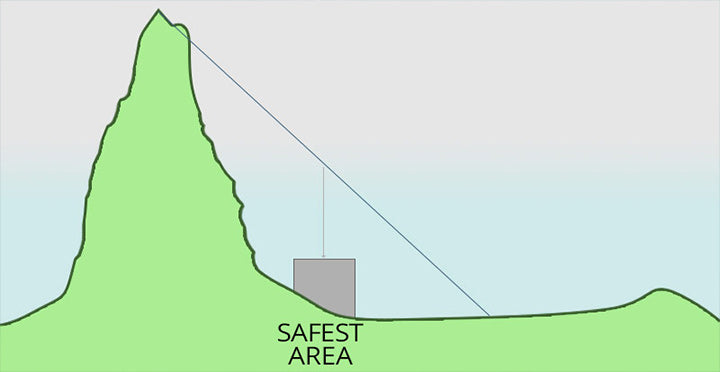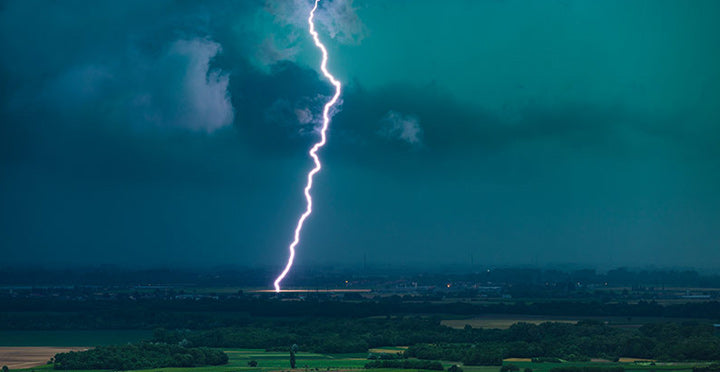We all love hot summer weather but the side effect - thunderstorms and thundery showers - often follows. If you are planning a walk the best thing to do is avoid being caught in a storm but it is always worth bearing some basic tips in mind in case you are caught out in the open when a storm appears....
Thunderstorms often follow periods of hot weather. As the atmosphere becomes more unstable and hot air from ground level rises to meet the cooler air above it condenses, forming droplets of water that, when the updraft of air is rapid enough, quickly form cumulonimbus "thunder" clouds, with a negative charge concentrated at the bottom of the cloud.
The negative charge is attracted to other clouds, airborne objects and the Earth and when this electrical attraction is strong enough, this imbalance is discharged as a lightning flash as powerful as 20-30,000 Amps.
Lightning strikes are not overly common, according to RoSPA there are roughly 3 fatal lightning strikes directly to a person each year, however golfing and hill walking are recreations where lightning strike does pose a danger so if planning a walk or other outdoor activity, it is worth considering what to do in the event of a storm, especially if your walk takes you to high and exposed areas.
So what should you do if caught outdoors in a storm?

Prevention: Check the Weather Forecast
The best way of dealing with a storm is to not get into the situation at all. "If Thunder Roars, Go Indoors" is the primary rule. Before heading out, check the weather forecast for the area that you are visiting. Check local forecasts for towns close by your walk, remembering that forecasts can be surprisingly different between two relatively close towns where they are separated by large hills such as in the Pennines, Peak District etc. If Thunderstorms are likely, postpone your walk. The hills have been there for tens of thousands of years - they will be there to visit on another day. Postpone your plans, take a walk somewhere less exposed where shelter is plentiful or travel to a different location with a better forecast.
When the Weather Changes
We all know that weather can be unpredictable, forecasts can be wrong and storms can develop quickly. So if caught out in a thunderstorm;
Calculate the Risk
You can calculate the distance of the lightning from you, and whether it is approaching or moving away, by timing the period between seeing the lightning flash and hearing the crack of thunder. When you see the flash count the seconds until the thunderclap than multiply this number by 300. This will give you an approximate distance, in metres, between you and the lightning. For instance, if you count 5 seconds, the storm is 1500m away (just under 1 mile), if you count 3 seconds then the storm is 900m away. What to do next depends on the distance the storm is away from you.
Lightning can strike as far as ten miles from the centre of the storm, so any gap less than 30 seconds means that there is a real threat and that you should evaluate your situation, planning your shelter straightway
Descend to Lower Ground
If the storm is approaching but still a fair distance away, and a route allows, you should consider making your way as quickly as possible to lower ground. If you can return to your vehicle, or seek shelter indoors in a village pub or similar until the storm passes, then so much the better
Unless the storm is significantly far away, avoid scrambling routes as a nearby strike can easily knock you off and cause a fall, and certainly avoid abseiling or climbing, lightning LOVES wet rope.
If You Are Caught in the Storm
Where NOT to shelter
Seeking shelter is the best advice but only in suitable locations.
Avoid caves or mine entrances - if lightning strikes the ground above it is likely to carry on through the cave - and through you!
Avoid standing beneath trees, either solitary trees or those in a small copse or field border. In a thicker wood or forest trail, the situation is different. You do not need to seek an exit from the wood into open ground, however, try to find a clear spot under the canopy cover, as far away from individual tree trunks as possible.
Move away from possible lightning rods
Move away from trees, fences, poles and any other erect structures - lightning can jump across from these to you.
Stay away from open water
Remember that lightning is caused by negatively charged water particles. Move away from any lakes, ponds or tarns as they can attract lightning and increase the chance of a strike close by
Identify the safest place to be
Lightning seeks the shortest route to earth. The aim is not to be the most prominent feature of the landscape, whilst staying away from other possible 'lightning rods'. If you are close to a crag or an outcrop of rocks, move to a point below the top of the ridge.
If you are close to a pinnacle, the safest area to be is half the distance away from the peak, as the height of the peak. Imagine a line drawn from the peak at 45 degrees, descending to the ground and position yourself roughly below the half-way point of that line. The peak acts as a lightning conductor for the area around it for a distance roughly equivalent to its height

Spread Out
Lightning current can jump from person to person. If in a group, you should spread out so that in the event of one member of your party suffering a strike, others are uninjured and able to give aid/call for rescue. Try to maintain a distance of at least 20 feet between all members of your party but remain within hearing distance
Be aware of metal objects
Walking poles etc are not considered to significantly increase risk of lightning strike (common sense dictates not to wave them in the air of course!) but if they do start to hum and/or spark then you should immediately place any metal objects at least 20 metres away, especially walking poles and umbrellas but also any other smaller metal items. Including your mobile phone. A waterproof pouch is invaluable in the event of a storm to enclose mobile phones, karabiners, watches, keys etc to keep them safe and dry away from your person.
If You Feel Signs of an Imminent Lightning Strike
If you feel your skin begin to tingle and hair standing on end - or as above metal poles begin to hum or spark this is an indicator of an imminent lightning strike, and this is the time to adopt an emergency "lightning position".
Reduce your height and insulate yourself
If you can, place your rucksack on the ground and sit on it. Keep hands and feet off the ground, draw knees up to the body and wrap arms around the knees to support yourself. This has the effect of both reducing your height for lightning looking for the shortest route to earth and insulating yourself (although not fully). The most important aim is to reduce your "footprint" on the ground, so if you are unable to sit or crouch on your pack, stand on top of it, NEVER lay down outstretched on the ground
The 'Lightning Crouch'
If you cannot sit on a rucksack or similar and are standing on the open ground Although you need to reduce your height, do not lie down. Crouch down, balanced on the balls of your feet with your heels together, place your hands over your ears or - if you can - your head between your knees with your hands behind your ears
It must be noted that many weather agencies stopped recommending the 'lightning crouch' so as not to infer that this was a means of negating risk. This is a last resort action only with only a slight reduction in risk - however in a serious situation slight is better than none
What next?
After 10 seconds of the lightning flash (or if no flash, 10-15 seconds after experiencing the warning signs of an impending strike), feel for the same signs again. If you still feel the warning signs, maintain the position. If not, continue with your main priority which is seeking shelter until the storm passes.

After The Storm
Wait 30 Minutes
Statistically, lightning strike is most likely to happen after the initial storm has passed With the danger apparently over, it is a mistake to head out into the open again until the storm is well and truly over - a strike can still occur even when the storm seems have passed by up to 10 miles.
If you were succesful in seeking shelter, remain there for at least 30 minutes to ensure all danger has passed.
Types of Lightning Strike
Direct Strike
The rarest form but often mistaken as the only type of strike is the direct lightning strike where the lightning hits you and travels directly through you to Earth.
Side Flash
A side flash occurs when the lightning hits another object and then "jumps" sideways through the air to strike you.
Ground Strike
Often overlooked but a very real danger and a reason for not scrambling and standing pressed against rocks etc for shelter, this occurs when lightning hits the ground and travels through or along the ground, hitting you as it does so.
If Lightning Strike Occurs
It is safe to touch a victim of lightning strike
A lightning strike is unlike industrial or household electrocution, which is where a mistaken belief comes from that it is dangerous to touch a strike victim. This is not the case, you cannot be electrocuted by them and it is important to call for help and administer first aid as necessary as quickly as possible









